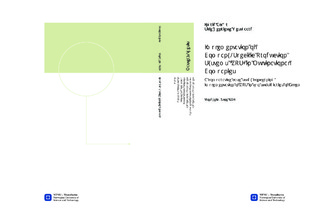| dc.description.abstract | In order for multinational manufacturing companies to strengthen their position in a competitive global market, continuous improvement of the companies’ operations has received an increasing focus since the 1990s. In order to develop a lasting culture for continuous improvement, an increasing number of companies have developed ‘improvement programs’ tailored towards the company’s specific operations. This type of improvement programs have been denoted as company-specific production systems (XPS), and are inspired by principles from Lean Manufacturing and the Toyota Production System (TPS). In Norway, the multinational materials producer Elkem has been one of the pioneers within XPS with its Elkem Business System (EBS). Elkem’s EBS center has since the early 2000s implemented EBS in most subsidiaries within the company. There has been a heated debate in research over the transferability of TPS, as some argue that TPS is a universal set of management tools that can be transferred everywhere, while others deny the universal transferability of TPS, emphasizing the unique socio-economic context in which TPS exists. This study adopts the contingency perspective, believing TPS to be universally transferable but subject to organizational and external factors which influence the implementation at the recipient site. The contribution of this study is to increase the understanding of the conditions that influence implementation of XPS in the subsidiaries of a multinational company (MNC). In order to accomplish this, a comparative case study of two manufacturing units in Elkem is conducted, investigating one plant in Norway (Elkem Salten) and one plant in Iceland (Elkem Iceland). The two plants were chosen on the basis of their many similarities (production facilities, size, number of employees), which on a general basis should qualify the plants for an equal starting point when implementing XPS. However, while Elkem Salten appears to have experienced great success when implementing XPS, Elkem Iceland has experienced many challenges and relapses. Consequently, this case study seeks to examine why the implementation of EBS has varied to such a large extent between the two plants. In order to investigate this issue, the study first identifies i) factors influencing the local EBS implementation at each plant, ii) factors influencing the inter-unit EBS related sharing between the plants. As the research approach of this study is explanatory, and the investigated events are contemporary and possible to observe directly, a case study design was chosen to carry out the research. Drawing on the strengths of such a research design, the study employs multiple sources of evidence such as: focused and in-depth interviews, direct observation and several types of documentation. Further, in order to guide the selection of empirical data, the study uses theory from five streams of literature: absorptive capacity theory, change management, institutional theory, corporate socialization theory and agency theory. The choice of literature is based on a literature review conducted as a preliminary study during the autumn of 2011, within the field of ‘transfer of procedural knowledge within MNCs’. The background for the comparative case study was a perception that Elkem Salten had achieved a higher level of success with its XPS implementation compared to Elkem Iceland. However, the findings of this study create a more nuanced impression of the current situation: Although Elkem Salten can be said to have had a more efficient XPS implementation, resulting in a more systemized approach to XPS, Elkem Iceland has in recent years shown significant improvement. Still, the plant lacks a sufficient systemization of the XPS implementation, resulting in a lower efficiency of the implementation process. Further, past events in the plant’s history have influenced the implementation of XPS, giving the plant a difficult start. Yet, the findings show that both plants have some common areas of improvement potential, such as increasing the motivation and involvement related to XPS among employees at the operating level. The study identifies 19 factors through the reviewed literature that are believed to have an influence on the implementation and inter-unit sharing of XPS within MNCs. These factors can be classified according to three levels of analysis: subsidiary level, corporate level and national level. The expected influence of the factors are formulated in 13 theoretical propositions, which are tested based on the empirical data. Four of the propositions find strong support and are thus expected to be generalizable to other MNCs. Further, a holistic perspective is used to evaluate all the factors, showing that they intertwine and influence each other across the three levels of analysis, and across the five theoretical perspectives. Although the discussion suggests a complex interaction of the identified factors, some particular factors are identified as major determinants for the different outcomes of the two plants. Of the identified factors related to implementation of XPS, the discussion shows that the organizational inertia at Iceland has had a major influence on the outset of the plant’s XPS implementation, and left a challenging basis for further implementation. Further, the plant at Salten has had a major advantage over the plant at Iceland due to a higher level of prior related knowledge of the plant manager, and the plant management’s higher level of knowledge acquisition. This advantage has resulted in a more systemized approach to the implementation process, and a higher level of cross-functional communication. Of the identified factors related to inter-unit sharing of XPS, the discussion reveals that the lack of standardization in XPS implementation has been an important underlying factor, causing the existence of other barriers to sharing. Most importantly, the lack of standardization has complicated the use of corporate socialization mechanisms. Further, the sharing between units in the case company has mainly been facilitated by an XPS knowledge center, acting as an intermediary. The empirical findings reveal that this arrangement has been a bottleneck in the XPS sharing process. These factors have commingled, and led to a limited sharing of XPS related knowledge in the case company. Therefore, many valuable experiences related to XPS implementation have not been shared between units, contributing to the high variation in the level of XPS implementation. For managers of multinational companies, the findings imply that managing XPS in a multinational company is a complex undertaking. The findings show that providing subsidiaries with theoretical knowledge of XPS tools and methodology is not enough in itself. In order to achieve higher levels of implementation, local managers must possess a practical understanding of how to translate XPS related knowledge to the every-day situation of the plant. Further, focus should be on systemizing the intra-unit, cross-functional communication as well as the inter-unit knowledge sharing. In addition, managers of the parent company must communicate the importance of XPS related knowledge sharing, and promote a common corporate identity to strengthen inter-unit ties within the MNC. This study provides two main contributions to the theory. First, the study’s findings indicate a strong link between the field of procedural knowledge transfer and the implementation and sharing of XPS in MNCs. Based on this link, a set of propositions for investigating XPS implementation and sharing in MNCs is provided for future research. Second, the study proposes a theoretical model which explains how the investigated theories interact to explain XPS implementation and sharing in multinational companies. | nb_NO |

